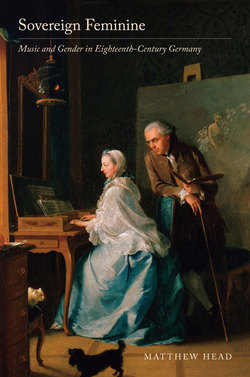Читать книгу Sovereign Feminine - Matthew Head - Страница 10
На сайте Литреса книга снята с продажи.
ОглавлениеILLUSTRATIONS
FIGURES
| 1. | Frontispiece of Johann Friedrich Reichardt, Musicalischer Almanach | |
| 2. | Richard Samuel, Portraits in the Characters of the Muses in the Temple of Apollo | |
| 3. | Maria Antonia Walpurgis, title page of Antonio Eximeno, Dell’origine e delle regole della musica | |
| 4. | Title-page engraving of Johann Friedrich Reichardt, Six Concertos pour le Clavecin à l’usage du beaux Sexe | |
| 5. | Title-page engraving of Johann Friedrich Reichardt, Wiegenlieder für gute deutsche Mütter | |
| 6. | Silhouette of Minna Brandes, in Operetten von C.F. Bretzner | |
| 7. | Engraving by Heinrich Sintzenich of a portrait of Minna Brandes by Rudolph Christian Schade | |
| 8. | Title page of Musikalischer Nachlass von Minna Brandes | |
| 9. | Title page of Juliane Reichardt, Lieder und Klaviersonaten | |
| 10. | Plan of Park Tiefurt, from Friedrich Menzel, Schloss Tiefurt | |
| 11. | Melchior Kraus, Felsen-Treppe bey der Stern Brücke im Herzl. Park bey Weimar | |
| 12. | Melchior Kraus, Performance of Die Fischerin | |
| 13. | Eugène Delacroix, Liberty Leading the People | |
| 14. | Anon., untitled [Eleonore Prohaska wounded in battle], from Wilhelm Oertel von Horn, Vier deutsche Heldinnen aus der Zeit der Befreiungskriege |
TABLES
| 1. | A selection of music for the fair sex by eighteenth-century German composers | |
| 2. | Johann Friedrich Reichardt, Wiegenlieder für gute deutsche Mütter, contents | |
| 3. | Musical numbers in Corona Schröter’s Die Fischerin | |
| 4. | Compositions by Sophie Westenholz | |
| 5. | Beethoven’s music for Goethe’s Egmont, op. 84 | |
| 6. | “Die Trommel gerühret”: text and translation | |
| 7. | “Die Trommel gerühret”: musical and poetic form | |
| 8. | Friedrich Schiller, “Würde der Frauen” |
MUSICAL EXAMPLES
| 1. | J.F.W. Wenkel, Clavierstücke für Frauenzimmer, no. 1, “Das Clavier” | |
| 2. | C. Nichelmann, Sei breve sonate da cembalo massime all’uso delle dame, Sonata No. 5, first, second, and third movements | |
| 3. | E.C. Dreßler, Melodische Lieder, no. 1, “Die Zufriedenheit” | |
| 4. | J.F. Reichardt, Gesänge fürs schöne Geschlecht, no. 1, “Vergnüget mich” | |
| 5. | J.F. Reichardt, Wiegenlieder für gute deutsche Mütter, no. 1, “So schlafe nun, du Kleine” | |
| 6. | M. Brandes, untitled allegro in D major for solo keyboard (a) mm. 1–41; (b) mm. 84–93 | |
| 7. | M. Brandes, “Seufzer,” for voice and keyboard | |
| 8. | M. Brandes, “Seufzer,” harmonic framework expressed as figured bass | |
| 9. | M. Brandes, “Das Traumbild,” for voice and keyboard | |
| 10. | C. Schröter, Die Fischerin, no. 1, “Der Erlkönig” | |
| 11. | C. Schröter, Die Fischerin, no. 3, “Wenn der Fischer’s Netz auswirft” | |
| 12. | C. Schröter, Die Fischerin, no. 10, “Ich hab’s gesagt” | |
| 13. | C. Schröter, Die Fischerin, no. 6, “Helft! Helft sie retten!” | |
| 14. | S. Westenholz, Theme with Variations in A major (SW II/2), theme | |
| 15. | S. Westenholz, Theme with Variations in A major (SW II/2), variation 9 | |
| 16. | S. Westenholz, Sonate à quatre mains in F major (SW II/3), first movement, mm. 1–13 | |
| 17. | S. Westenholz, Sonate à quatre mains in F major (SW II/3), first movement, mm. 57–67 | |
| 18. | S. Westenholz, Theme with Variations in A major (SW II/2), variation 11 | |
| 19. | S. Westenholz, Theme with Variations in A major (SW II/2), variation 12, second episode, mm. 34–52 | |
| 20. | S. Westenholz, Sonate aller Sonaten in C minor (SW I/5), third movement, mm. 1–84 | |
| 21. | Beethoven, Egmont, “Die Trommel gerühret” (Klärchen), mm. 27–30 | |
| 22. | Beethoven, Egmont, “Die Trommel gerühret” (Klärchen), mm. 36–44 | |
| 23. | Beethoven, Egmont, “Freudvoll und leidvoll” (Klärchen), mm. 16–21 | |
| 24. | Beethoven, Egmont, melodrama, Egmont’s monologue, mm. 1–14 | |
| 25. | Beethoven, Egmont, melodrama, Liberty’s apparition, mm. 15–25 | |
| 26. | Beethoven, Egmont, melodrama, Liberty’s pantomime, mm. 35–51 | |
| 27. | Beethoven, Egmont, Victory Symphony, mm. 9–15 | |
| 28. | J.F. Reichardt, “Würde der Frauen,” setting of stanzas 1 and 2 | |
| 29. | A. Thierry, “Würde der Frauen,” setting of stanza 1 | |
| 30. | A. Thierry, “Würde der Frauen,” setting of stanza 6 |
